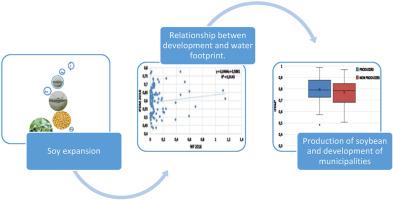Environmental Development ( IF 4.7 ) Pub Date : 2021-09-08 , DOI: 10.1016/j.envdev.2021.100670 João Francisco Severo dos Santos 1 , Líliana Pena Naval 1

|
The objective of this study was to verify the relationship between the Water Footprint (WF) of soy production and the socioeconomic development of the municipalities located in the recent agricultural expansion areas of the Cerrado (brazilian savanna), between 2007 and 2016. For this purpose, the development of soy producing and non-producing municipalities was compared, according to different categories of consolidation time and economic weight of this culture, through multivariate analysis. The correlation between the development index and the absolute WF was calculated. The results found refute the hypothesis that the development of producing municipalities is a reflection of the economic advances provided by the soybean producer in these areas. Those who have consolidated their soy production for over 30 years are the ones that showed the best overall development. However, they did not show good results in the distribution of income and employment creation. They show or register worse health rates when compared to municipalities that do not produce soy in the same region. The size of the areas destined to the cultivation of this conmodity is associated to local climate changes that put productive and environmental sustainability at risk, since, for each unit of growth of the municipal development indicator, water consumption increased 17 times and it was found the water footprint of soybeans is inversely linked to the municipal development index.
中文翻译:

大豆水足迹和社会经济发展:巴西塞拉多(巴西稀树草原)新农业扩张区的分析
本研究的目的是验证 2007 年至 2016 年间大豆生产的水足迹 (WF) 与位于塞拉多(巴西大草原)最近农业扩张区的城市的社会经济发展之间的关系。为此目的, 根据该文化的巩固时间和经济权重的不同类别,通过多变量分析比较了大豆生产和非生产直辖市的发展。计算发展指数与绝对WF之间的相关性。发现的结果驳斥了这样一种假设,即生产城市的发展反映了这些地区大豆生产者提供的经济进步。那些将大豆生产巩固了 30 多年的人是那些表现出最佳整体发展的人。然而,它们在收入分配和创造就业方面并没有表现出良好的效果。与同一地区不生产大豆的城市相比,它们显示或记录的健康率更差。这种商品的种植面积与当地气候变化有关,这使生产和环境可持续性面临风险,因为对于城市发展指标的每个单位增长,用水量增加了 17 倍,并且发现大豆的水足迹与市政发展指数成反比。与同一地区不生产大豆的城市相比,它们显示或记录的健康率更差。这种商品的种植面积与当地气候变化有关,这使生产和环境可持续性面临风险,因为对于城市发展指标的每个单位增长,用水量增加了 17 倍,并且发现大豆的水足迹与市政发展指数成反比。与同一地区不生产大豆的城市相比,它们显示或记录的健康率更差。这种商品的种植面积与当地气候变化有关,这使生产和环境可持续性面临风险,因为对于城市发展指标的每个单位增长,用水量增加了 17 倍,并且发现大豆的水足迹与市政发展指数成反比。











































 京公网安备 11010802027423号
京公网安备 11010802027423号